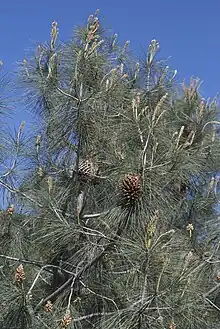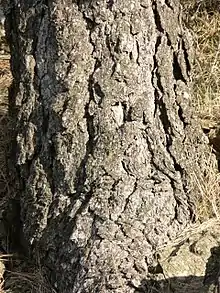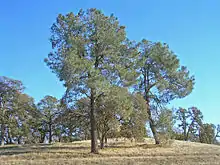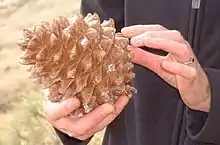Pinus sabiniana
Pinus sabiniana (sometimes spelled P. sabineana), with vernacular names including towani pine, foothill pine, gray pine, bull pine, and digger pine,[2][3][4][5][6] is a pine endemic to California in the United States.[7][8] Some sources discourage using the name "digger pine," considering it pejorative [3][4] ("digger" was a slur commonly used to refer to Indigenous Americans in the Great Basin and California).[9]
| Pinus sabiniana | |
|---|---|
 | |
| Scientific classification | |
| Kingdom: | Plantae |
| Clade: | Tracheophytes |
| Clade: | Gymnosperms |
| Division: | Pinophyta |
| Class: | Pinopsida |
| Order: | Pinales |
| Family: | Pinaceae |
| Genus: | Pinus |
| Subgenus: | P. subg. Pinus |
| Section: | P. sect. Trifoliae |
| Subsection: | P. subsect. Ponderosae |
| Species: | P. sabiniana |
| Binomial name | |
| Pinus sabiniana | |
Description
The Pinus sabiniana tree typically grows to 36–45 feet (11–14 m), but can reach 105 feet (32 m) feet in height. The needles of the pine are in fascicles (bundles) of three, distinctively pale gray-green, sparse and drooping, and grow to 20–30 cm (8–12 inches) in length. The seed cones are large and heavy, 12–35 cm (4+3⁄4–13+3⁄4 inches) in length and almost as wide as they are long.[5][3][10] When fresh, they weigh from 0.3 to 0.7 kilograms (0.7 to 1.5 lb), rarely over 1 kilogram (2.2 lb).[11] The male cones grow at the base of shoots on the lower branches.[5][3][10]
 Pollen cones
Pollen cones Bark
Bark.jpg.webp) Cone, seeds, and Resin
Cone, seeds, and Resin_-_foliage_(30485878313).jpg.webp) Foliage
Foliage
Distribution and habitat

Pinus sabiniana grows at elevations between sea level and 1,200 metres (4,000 ft) and is common in the northern and interior portions of the California Floristic Province. It is found throughout the Sierra Nevada and Coast Ranges foothills that ring the Central, San Joaquin and interior valleys; the Transverse and Peninsular Ranges; and Mojave Desert sky islands.[3][10] Multiple specimens have also been found in Southern Oregon as well.[12][13] It is adapted to long, hot, dry summers and is found in areas with an unusually wide range of precipitation: from an average of 250 mm (10 in) per year at the edge of the Mojave to 1,780 mm (70 in) in parts of the Sierra Nevada.[11] It prefers rocky, well drained soil, but also grows in serpentine soil and heavy, poorly drained clay soils. It commonly occurs in association with Quercus douglasii,[14] and "Oak/Foothill Pine vegetation" (also known as "Oak/Gray Pine vegetation") is used as a description of a type of habitat characteristic within the California chaparral and woodlands ecoregion in California, providing a sparse overstory above a canopy of the oak woodland.
 P. sabiniana in chaparral habitat in Sacramento Valley
P. sabiniana in chaparral habitat in Sacramento Valley P. sabiniana in mountain foothills habitat in Pinnacles National Monument
P. sabiniana in mountain foothills habitat in Pinnacles National Monument
Ecology and uses
Pinus sabiniana needles are the only known food of the caterpillars of the Gelechiid moth Chionodes sabinianus. Fossil evidence suggests that it has only recently become adapted to the Mediterranean climate as its closest relatives are part of the Madrean pine-oak woodlands found at higher elevations in the southwest US and Mexico.[15] Some Native American groups relied heavily on sweet pine nuts for food[16] and are thought to have contributed to the current distribution pattern, including the large gap in distribution in Tulare County. Native Americans also consumed the roots.[17]
Special uses
Protein and fat nutritional value of the seed are similar to Pinus pinea seeds and figured in the local indigenous diet.[18]
Wood uses historically were determined by its particular characteristics, e.g., 0.43 mean specific gravity nearly equal to Douglas-fir (Pseudotsuga menziesii); strength properties similar to ponderosa pine; Kraft pulps high in bursting with tensile strength comparable to some northern conifer pulps; and foothill stands loggable in winter, when higher-altitude species were inaccessible. However, the high amounts of resin and compression wood, the often crooked form, heavy weight, and low stand density, made it expensive otherwise to log, transport and process. Commercial value decreased by the 1960s,[18] to limited use for railroad ties, box "shook",[19] pallet stock, and chips.
It may still offer potential as windbreak shelterbelt plantings.[18]
The main turpentine constituent, heptane, an alkane hydrocarbon, at about 3 percent of needle and twig oil,[18] is unusual in botany; the only other source in nature perhaps being the Pittosporum resiniferum known as "petroleum nut" or kerosene tree.
Taxonomy
Common name
The name digger pine supposedly came from the observation that the Paiute foraged for its seeds by digging around the base of the tree, although it is more likely that the term was first applied to the people; "Digger Indians" was in common use in California literature from the 1800s. The historically more common name digger pine is still in widespread use. The Jepson Manual advises avoiding this name as the authors believe "digger" is pejorative in origin.[20][21] It is also sometimes thought of as a pinyon pine, though it does not belong to that group.
| Language | Name |
|---|---|
| Achumawi | tujhalo |
| Awaswas Ohlone | hireeni (pine tree); saak (pinenut) |
| Chalon Ohlone | šaak (pinenut) |
| Chimariko | hatcho |
| Chochenyo Ohlone | saak (pinenut) |
| Chukchansi Yokuts | ton' (pinenut); shaaxal' (pine sap) |
| Karuk | axyúsip |
| Klamath | gapga [22] |
| Konkow | tä-nē’ [23] |
| Maidu | towáni |
| Mono | tunah |
| Mutsun Ohlone | hireeni; saak (pinenut) |
| Patwin | tuwa; sanank (pinenut) |
| Rumsen Ohlone | xirren |
| Southern Sierra Miwok | sakky |
| Wappo | náyo |
| Wintu | xisi (unripe pinenut); chati (ripe pinenut) |
| Yana | c’ala’i [22] |
Botanical name

The scientific botanical name with the standard spelling sabiniana commemorates Joseph Sabine, secretary of the Horticultural Society of London. Some botanists proposed a new spelling sabineana, because they were confused with Latin grammar. The proposal has not been accepted by the relevant authorities (i.e. United States Department of Agriculture, The Jepson Manual or Germplasm Resources Information Network (GRIN).[2][3][5][24] The GRIN notes that the spelling sabiniana agrees with a provision in the Vienna Code of the International Code of Botanical Nomenclature, the governing body of botanical nomenclature. In that code, recommendation 60.2C states that personal names can be Latinized in species epithets: 'Sabine' is Latinised to sabinius, with the addition of the suffix "-anus" (pertaining to) the word becomes sabiniana (In Latin, trees are feminine, irrespective if the word ends with a masculine suffix, i.e. pinus).[24][25] The GRIN database notes that Sabine's last name is not correctable and therefore Pinus sabiniana is the proper name for the species.
Notes
- Farjon, A. (2013). "Pinus sabiniana". IUCN Red List of Threatened Species. 2013: e.T42413A2978429. doi:10.2305/IUCN.UK.2013-1.RLTS.T42413A2978429.en. Retrieved 19 November 2021.
- "Data Source and References for Pinus sabiniana (California foothill pine)". USDA PLANTS. Retrieved 20 October 2012.
- Hickman, James C., ed. (1993). "Pinus sabiniana". The Jepson Manual: Higher Plants of California. University and Jepson Herbaria. Retrieved 20 October 2012.
- Earle, Christopher J., ed. (2018). "Pinus sabiniana". The Gymnosperm Database. Retrieved 8 February 2019.
- "Pinus sabiniana". Calflora. Berkeley, California: The Calflora Database. Retrieved 20 October 2012.
- "Pinus sabiniana". Archived from the original on 25 February 2002. Retrieved 15 July 2022.
- Cole 1939.
- Beissner 1909.
- Lonnberg, Allan (1981). "The Digger Indian Stereotype in California". Journal of California and Great Basin Anthropology. 3 (2).
- "Classification for Kingdom Plantae Down to Species Pinus sabiniana Douglas ex Douglas". USDA PLANTS. Retrieved 20 October 2012.
- Powers, Robert F. (1990). "Pinus sabiniana". In Burns, Russell M.; Honkala, Barbara H. (eds.). Conifers. Silvics of North America. Washington, D.C.: United States Forest Service (USFS), United States Department of Agriculture (USDA). Vol. 1. Retrieved 17 March 2016 – via Southern Research Station.
- Frank Callahan. "Discovering Gray Pine (Pinus sabiniana) in Oregon" (PDF). Npsoregon.org. Retrieved 24 March 2022.
- "Pinus sabiniana (gray pine) description - The Gymnosperm Database". www.conifers.org. Retrieved 26 February 2023.
- Hogan 2008.
- Munz, P. "A California Flora and supplement" University of California Press
- Peattie, Donald Culross (1953). A Natural History of Western Trees. New York: Bonanza Books. p. 94.
- Whitney, Stephen (1985). Western Forests (The Audubon Society Nature Guides). New York: Knopf. p. 409. ISBN 0-394-73127-1.
- "Digger Pine". USDA Forest Service Southern Research Station. Retrieved 10 February 2022.
 This article incorporates text from this source, which is in the public domain.
This article incorporates text from this source, which is in the public domain. - "Shook". 23 December 2021.
- Hickman, J.C. (Ed.) "The Jepson Manual, Higher Plants of California". University of California Press, Berkeley, 1993 p.120.
- Hickman, James C., ed. (1993). "Pinus sabiniana". The Jepson Manual: Higher Plants of California. University and Jepson Herbaria. Retrieved 6 January 2011.
- Hinton, Leanne (1996). Flutes of fire :essays on California Indian languages. Berkeley, CA: Heyday Books. ISBN 978-0-930588-62-5.
- Chesnut, Victor King (1902). Plants used by the Indians of Mendocino County, California. Government Printing Office. p. 408. Retrieved 24 August 2012.
- "Pinus sabiniana Douglas". Germplasm Resources Information Network. Agricultural Research Service, United States Department of Agriculture. Retrieved 1 October 2010.
- International Code of Botanical Nomenclature. 2006. Recommendation 60C.2. Accessed online: 1 October 2010.
References
- Cole, James E. (1939). The Cone-bearing Trees of Yosemite: Digger Pine.
- A. Farjon (2005). Pines: Drawings and descriptions of the genus Pinus. Brill. ISBN 90-04-13916-8
- Hogan, C. Michael (2008). Stromberg, Nicklas (ed.). "Blue Oak (Quercus douglasii)". GlobalTwitcher. Archived from the original on 28 February 2012.
- Discovery Channel (2010), MythBusters, Episode 138
- Beissner, Ludwig (1909). Handbuch der Nadelholzkunde: Systematik, Beschreibung, Verwendung und Kultur der Ginkgoaceen, Freiland- Coniferen und Gnetaceen. Für Gärtner, Forstleute und Botaniker. P. Parey.
- Lonnberg, Allan (1981). "The Digger Indian Stereotype in California". Journal of California and Great Basin Anthropology. 3 (2).
Further reading
- Chase, J. Smeaton (1911). "Pinus sabiniana (Digger-pine, Gray-pine, Piñon-pine, Nut-pine)". Cone-bearing Trees of the California Mountains. Eytel, Carl (illustrations). Chicago: A.C. McClurg & Co. pp. 28–30. LCCN 11004975. OCLC 3477527.
External links
 Media related to Pinus sabiniana (category) at Wikimedia Commons
Media related to Pinus sabiniana (category) at Wikimedia Commons Data related to Pinus sabiniana at Wikispecies
Data related to Pinus sabiniana at Wikispecies- Jepson eFlora, The Jepson Herbarium, University of California, Berkeley
- USDA PLANTS Treatment for Pinus sabiniana (California foothill pine)
- Pinus sabiniana in the CalPhotos photo database, University of California, Berkeley
